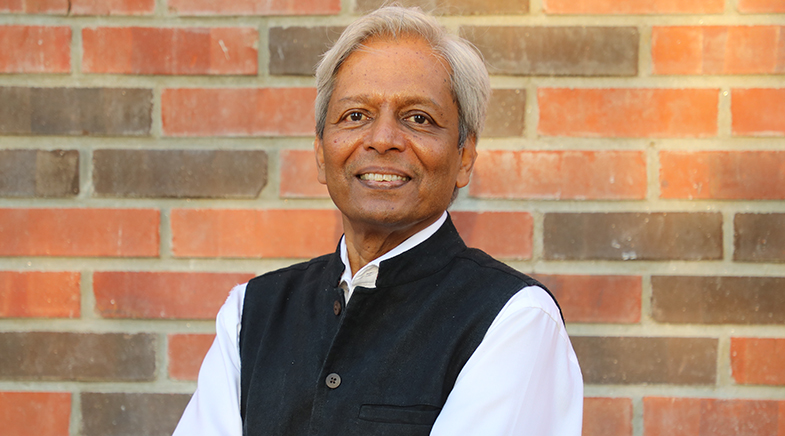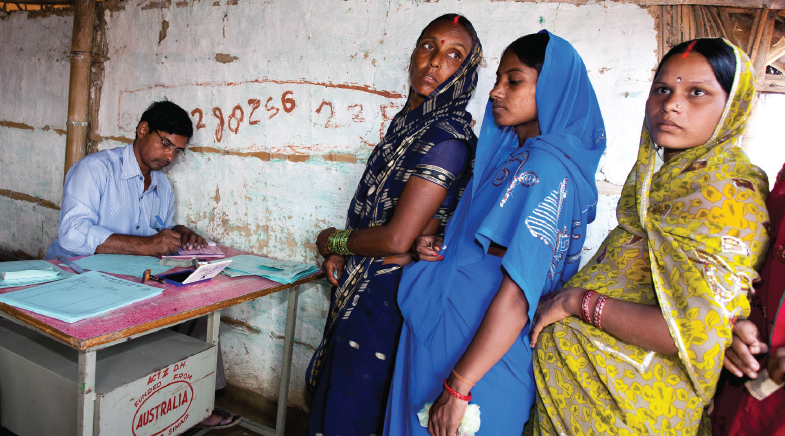Long live the queen!
-
- from Shaastra :: vol 03 issue 05 :: Jun 2024

A queen ant manages a long lifespan despite overeating and being inactive. Researchers offer insights into her charmed life.
How long can we live? How large can we become? Do answers to these questions have any relationship to how many offspring we can bear and raise? The answers lie not just in our biology but also in the way we create and live in our societies. Three major factors — nature, nurture and neighbours — are at play in the growth and function of every organism, and each factor is as important as the other.
In many animals, reproducing tends to shorten lifespan because resources are diverted towards having offspring rather than maintaining the body. In some social insects, the queen is the only reproductive individual, but lives much longer than workers, who cannot reproduce at all. In Harpegnathos saltator ants, discussed here, the queen lives about five times longer than workers do. Insights and hypotheses from ethology and evolutionary biology, and the tools of contemporary molecular and cell biology, tell us just how this happens.
The study of the natural history of ants is centuries old. These reports were invaluable for their pathbreaking descriptions despite some errors in classification because ants of the same colony can have dramatically different morphs based on the tasks they carry out within the colony. In 1699, German naturalist and artist Maria Sibylla Merian travelled to Suriname and spent a year and a half there. Her book Metamorphosis insectorum Surinamensium is a science and art treasure. Of course, no mention of ants can be made without referring to E.O. Wilson and his magnum opus The Ants, co-authored with Bert Hölldobler, a book that every library must have. These and the work of thousands of researchers give us observations of the life cycle of ants, their diversity and their interactions with their environment.
Studies on the natural history of wasps, ants and social insects, in general, greatly stimulated evolutionary biologists to ask questions on the selective forces at play in the emergence of apparent altruism in insect societies, of the wide range of morphologies and the division of labour, and, importantly, on the emergence of colonies of a reproductive queen and workers 'dedicated' to other tasks.
The entire period of the 20th century (and beyond) saw the development of tools of chemistry, molecular biology, genetic engineering, microscopy and the ability to document behaviour at the highest resolution.
The mixing and matching of these tools has allowed an extraordinary diversity of organisms and behaviour to be studied. They also illustrate how studying any organism brings value to the study of any other, and demonstrate the integrative nature of all of biology. Since all organisms share common evolutionary origins, they also share genes and molecules, and the interactions between them. Yet, nature mixes and matches these genetic and molecular toolkits of evolution in different ways, so there are always surprises.
THE KEY
An example of such a surprise is insulin signalling. The insulin signalling pathway in humans is a complex biochemical cascade that plays a crucial role in regulating glucose levels, in metabolism, and in cell growth. The pathway begins when insulin, a hormone produced by the pancreas, binds to the insulin receptor (IR) on the surface of target cells such as muscle, fat, or liver cells. This binding triggers a cascade of molecular events that, in humans, maintains blood glucose levels and metabolic balance. Dysregulation of this pathway is associated with metabolic disorders such as type 2 diabetes and obesity.
Introducing a monthly column that will explore themes on nature, nurture and neighbourhood in the shaping of form and function.
Insulin signalling is also used in insects, and the core molecules of the pathway are the same as in humans. In many aspects, its function is also conserved. In insects, too, the insulin pathway plays a crucial role in regulating growth, development, metabolism, and longevity. But there are also important differences in the physiological outcomes of insulin signalling compared to humans. In many insects, such as fruit flies and ants, reduced insulin signalling is associated with longer lifespan. This is in contrast to humans, where increased insulin signalling is often linked to metabolic health. In eusocial insects like ants, the insulin signalling pathway is intricately linked to reproductive status and longevity. Reproductive individuals exhibit altered insulin signalling that supports both reproduction and extended lifespan. This raises a puzzle about the contrasting effects of insulin in insects and human, and within insects how the contrasting effects on fecundity and lifespan can be effected by the same signalling pathway. This puzzle was resolved in a 2022 study (bit.ly/ant-insulin).

In eusocial insects, such as ants, there is a clear distinction in lifespan between the reproductive queens and the non-reproductive workers, despite their having similar genetic backgrounds. In the ant species Harpegnathos saltator, when the queen dies, some workers can become reproductive pseudo-queens called gamergates. These gamergates exhibit a dramatic increase in lifespan compared to regular workers. The process of a worker becoming a gamergate involves massive changes. Their social behaviours change from leaving the nest for foraging to staying inside to breed; they need to grow ovaries, which workers don't have; and they need to undergo other physical changes in shape and size.
The insulin signalling pathway plays a crucial role in the transition to the gamergate state and the associated increase in lifespan. In gamergates, insulin expression in the brain is increased, which boosts the synthesis of lipids and other necessary substances for reproduction. This role of insulin signalling is not different from what it is known to do in other species. The surprise is what it does to lifespan. In other species, higher insulin signalling is associated with reduced lifespan. But in these gamergates, it needs to both increase reproduction and increase lifespan by up to five times. The authors of this study show how this might happen.
REPRODUCTION AND LONGEVITY
The insulin pathway splits into two branches: one leading to the activation of another signalling pathway, called the mitogen-activated protein kinase (MAPK) pathway, associated with reproduction; the other activates a second pathway known as Akt/forkhead box O (Akt/FOXO) pathway, linked to longevity.
In gamergates, the MAPK branch of the insulin pathway is activated, promoting reproductive activities. Simultaneously, the Akt/FOXO branch is suppressed, particularly in the fat body (an organ in insects equivalent to the liver and adipose tissue in humans). Because other studies have shown that low Akt/FOXO in the fat body is seen in longer lifespan conditions, the authors conclude that this inverse regulation of the second branch of the insulin pathway must be how insulin signalling in gamergates results both in increased reproduction and longer lifespan.
For example, genes related to insulin production are up-regulated in the gamergate brain. Interestingly, the developing ovaries of gamergates produce proteins that antagonise one arm of insulin signalling, reducing Akt activity, which correlates with longevity.
Gamergates show significant changes in their metabolism, including increased lipid mobilisation from the fat body to the ovaries to support egg production. This altered lipid metabolism is a critical aspect of how these ants manage to sustain both high reproduction and longevity.
By uncovering the role of insulin signalling and its differential regulation, researchers have established how ants achieve a balance between reproduction and longevity.
The key to the extended lifespan of gamergates seems to be a delicate balance in insulin signalling. While insulin promotes reproductive activities through the MAPK pathway, the suppression of the Akt/FOXO pathway, facilitated by proteins such as one called Imaginal morphogenesis protein-Late 2 (Imp-L2) produced in the ovaries, helps extend the lifespan. Thus, while the insulin pathway promotes ovarian development, the ovaries themselves produce components that suppress the negative effects on longevity. This selective regulation allows gamergates to enjoy the benefits of high reproductive activity without the usual cost of reduced lifespan.
This sheds light on the unique adaptations of social insects such as ants, where a single individual or a few individuals bear the reproductive responsibility of the entire colony and live much longer than their non-reproductive counterparts. By uncovering the role of insulin signalling and its differential regulation, researchers have provided insights into how these ants achieve this remarkable balance between reproduction and longevity. Understanding these mechanisms could have broader implications for studying ageing and lifespan in other organisms.
This study also illustrates how decades of growth of tools and fundamental understanding in molecular biology have allowed such an insightful understanding of a complex biological phenomenon. A variety of genetic and molecular techniques were employed to investigate the differences in insulin signalling pathways between the reproductive and non-reproductive castes. These methods included RNA sequencing, gene expression analysis, phylogenetic analysis, in situ hybridisation, immunofluorescence, Western blotting, and functional assays using synthetic peptides and inhibitors.
The researchers performed RNA sequencing on tissues important for reproduction and metabolism (brain, ovary, and fat body) from workers, gamergates, and revertants. This allowed them to compare the gene expression profiles between these different castes. The expression levels of genes were analysed to identify differentially expressed genes between workers and gamergates, and between gamergates and revertants that become workers again. The identified differentially expressed genes provided insights into the molecular changes associated with caste transition and longevity. Bioinformatics approaches were crucial and allowed the differentially expressed genes to be subjected to what is called gene ontology analysis to identify enriched biological processes, such as fatty acid synthesis and insulin signalling, during the transition from worker to gamergate. A phylogenetic analysis of genes related to insulin signalling across 71 Hymenopteran species (ants, bees, wasps, and sawflies) was done using publicly available databases. This analysis helped in understanding the conservation and divergence of insulin-like peptides in these species. The localisation of insulin messenger RNA in the brain was done using a technique called in situ hybridisation. This technique involved using labelled RNA probes that hybridise to specific mRNA sequences in tissue sections.

Next, a method called immunofluorescence was employed to visualise the distribution of insulin/insulin-like growth factor (IGF) proteins in the brain and ovary. Here, antibodies specific to these proteins were used to 'mark' them with a fluorescent label, and the resulting signals were observed under a microscope. High-resolution microscopy allowed the identification of the cells expressing insulin-like proteins. Proteins switch between active and inactive states by a process called phosphorylation. A method called western blotting was used to measure the levels of activation of the MAPK and Akt/FOXO pathways of insulin signalling in various tissues. This method involved separating proteins by gel electrophoresis, transferring them to a membrane, and probing with specific antibodies to detect protein phosphorylation levels.
To test the role of insulin in reproduction, synthetic insulin peptides were injected into worker ants. The effects on ovary development and duelling behaviour (where workers duel with developing gamergates to permit only one queen in a colony) were then assessed. Pharmacological inhibitions were used to investigate the role of MAPK signalling in ovary growth. By injecting the inhibitors into workers and measuring oocyte development, the importance of MAPK activity in reproduction could be determined. Quantitative RT-PCR — a sensitive method used to determine levels of gene-expression — was used to validate the levels of key genes identified by RNA sequencing. This technique involves amplifying specific sequences of messenger RNA and quantifying their abundance in real time.
Studying any organism brings value to the study of any other; it demonstrates the integrative nature of all of biology.
Versions of proteins in the insulin pathway with genetically engineered tags were produced in cell cultures and purified. These proteins were used in functional assays to study their effects on insulin signalling pathways. Purified proteins were used to treat dissected fat body tissues from worker ants to study their effects on reproductive and other tissues.
THE BIG PICTURE
Thus, a simply stated conclusion — 'the insulin pathway works in two ways to allow reproduction and longevity' — has, at its back end, a comprehensive array of genetic and molecular techniques to elucidate the mechanisms underlying the extended lifespan and reproductive capabilities of gamergate ants. More broadly, it illustrates the interdisciplinary toolkit that is needed to unravel how nature, nurture and societies shape complex behaviour and lives. At the intellectual foundation in the use of these molecular biology tools lies thousands of 'human-years' of study in ecology and evolution.
Future research could explore how these findings apply to other eusocial insects such as bees and termites. Additionally, studying the molecular mechanisms behind the selective activation and suppression of different branches of the insulin signalling pathway could reveal new targets for interventions in ageing and longevity, not just in ants but even in other organisms.
Have a
story idea?
Tell us.
Do you have a recent research paper or an idea for a science/technology-themed article that you'd like to tell us about?
GET IN TOUCH















